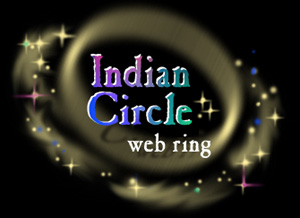The Indian
Circle website focuses on connecting Internet web pages
of federally recognized American Indian Tribes via the use
of a “web ring” (Seminole Tribe of Florida,
No Date). The Indian Circle website is maintained by the
Seminole Tribe of Florida and restricts the content of its
web ring solely to federally recognized tribal sites. According
to Indian Circle, web rings provide the World Wide Web with
a different way to organize websites by grouping sites with
similar content and linking them together in a circle. These
sites create a cyclical organizational structure, allowing
users to jump to adjacent sites by clicking “Previous”
or “Next” link buttons, eventually arriving
at the original page after all of the sites have been sequentially
processed. From the web ring itself or the hyperlink index
of tribal sites, Indian Circle asserts that users will be
able to reach most American Indian tribes on the Internet,
denoting itself as “the first step on the American
Indian Internet network” (Seminole Tribe of Florida,
No Date).

(Seminole Tribe of Florida, No Date) |

(Seminole Tribe of Florida, No Date) |
The graphical theme pervasive throughout Indian Circle
incorporates a starry sky background image with interspersed
circular patterns. Although this site is maintained by the
Seminole tribe, there is an absence of any photographic
images of or relating to the Seminoles or any other tribe.
The only image representation found on Indian Circle is
a multicolored “medicine man” appearing to have
blurred circular patterns superimposed upon him. The colored
swirl-like strokes superimposed over the medicine man image
touch upon stylistic notions associated with “Peyote
art,” however further analysis into this matter is
beyond the scope of this study.
Indian Circle’s main feature is to provide a web ring
service, which cyclically link federally recognized tribal
websites together. Each American Indian website holds equal
weight within the ring, connecting tribal members throughout
the United States based upon their sovereign recognition.
Indian Circle’s “Participation” webpage
highlights the steps and instructions for becoming a member
of the ring. The construction of this page exhibits a more
complex programming backend than most other sites I encountered.
The CGI scripting language is used to create an online submission
form that stores detailed information about potential web
ring candidates within a database. Once tribal groups have
received acceptance notification, they are instructed to
download the Indian Circle web ring image and place it on
their homepage. Indian Circle then provides accepted sites
with dynamic HTML code that embeds specific site identification
information within the Indian Circle graphic. By way of
a CGI scripting agent, this graphic is transformed into
a dynamic link, placing the specific tribal site within
the broader web ring structure.
 (Seminole Tribe of Florida, No
Date)
(Seminole Tribe of Florida, No
Date) |
Indian Circle’s creation and use of this sophisticated
web application allows the web ring to dynamically evolve
as more tribal groups join and the communal network expands.
Opposed to congregator sites’ static server-side indexing
and categorical placement of tribal website links, Indian
Circle relies on direct client-side involvement to ensure
community continuance and growth. In a movement away from
a standard hyperlink index, the cyclical Indian Circle web
ring integrates cultural aesthetics rooted in pan-Indian
off-line cultural identity within the virtual context of
the Internet. Paula Gunn Allen’s (1986) Sacred Hoop
is the primary watershed text which deals most centrally
with the concept of the hoop or “sacred circle”
in native traditions. Particularly, Allen’s work uses
cross-tribal concepts of the hoop as a metaphor or symbol
of individual and community balance. The structural decision
to integrate this circular metaphor common across tribal
groups plays a central role in establishing commonalities
among web ring members by creating a navigational experience
markedly symbolic of American Indian culture. Members’
recognition of and interaction within this organizational
structure aid in creating a unified group identity and sustaining
an online community structure rooted in a distinctive cultural
aesthetic.
NativeWeb and Indian Circle provide examples of websites
aiming to foster broader social cohesion among a wide range
of tribal groups. The emergence of these sites provides
a contextual setting for members to ascribe to and negotiate
between specific tribal and broader pan-Indian identities.
As seen within these sites, careful decisions regarding
content and structure play key roles in fostering interaction,
establishing community, and shaping group identity. Content-based
and structural decisions profoundly impact how members recognize
and ascribe to group identity and socially organize. These
markedly unique approaches to supratribal website construction
reflect the different ways ethnic distinction appears, group
identity asserted, and broader community structure is formed
on the Internet.
|

